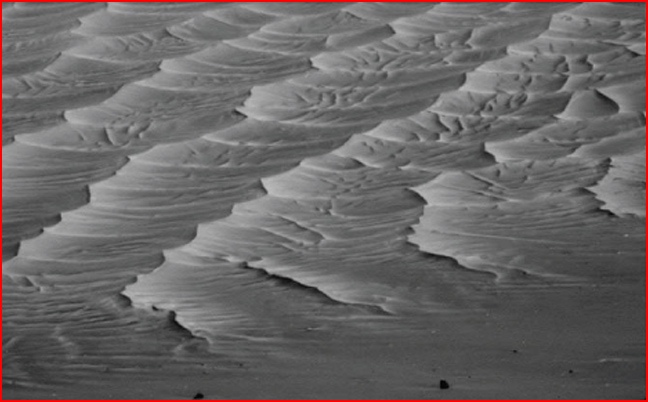
home •
about •
essential guide •
picture of the day •
thunderblogs •
news •
multimedia •
predictions •
products •
get involved •
contact
picture of the day archive subject index
MER B Opportunity sees the bottom of Victoria crater. Credit: NASA/JPL
Oct 19, 2007
Victoria's other SecretsAfter months of delay and near disaster, Opportunity is rolling into Victoria crater. The signs of possible electric discharge events are increasingly apparent.
The latest of the dust storms that periodically engulf Mars has subsided and Opportunity is beginning an analysis of Victoria crater. After being kept on the rim for almost two years, the MER has returned several images of the inner walls. The walls are composed of shattered layers and the sloping surface that it is following downward is very similar to the "cobbles" discovered in the plains of Meridiani.
In a previous Picture of the Day, we wrote that the silicon dioxide rocks and their association with hematite ripples, or "dunes," might be indicative of strong electric currents that surged beneath the surface. Those currents probably generated very powerful magnetic fields that could have ripped the rock into ultra-fine dust and compressed it into hematite "blueberries." The image at the top of the page demonstrates the effect such currents might have if they struck and stuck as it were, like a giant lightning bolt lasting perhaps a few seconds, burning in one spot.
We have taken notice in past articles that Victoria crater exhibits many anomalies if it is considered from a strictly impact-oriented scenario. Space-based image platforms have revealed it to have many attributes reminiscent of other craters on Mars that are thought to be electrical in nature. Mars is not alone in that regard, since other planets and moons share similar features.
The MER A Spirit and the MER B Opportunity have provided researchers with a tremendous advantage, because they have enabled comparisons between space and surface perspectives. Victoria crater's structure has been viewed from space and it could possibly be electrical in origin. The images from Opportunity have added weight to the Electric Universe theory by uncovering more planetary scarring evidence in the crater floor.
The most obvious is the fine structure that remains engraved on the bottom. No explosive blast ever recorded has left such a pattern behind. No, the craters that explosions make are far more disrupted and far more chaotic in all respects. They do not leave melted and solidified ripples with knife-edged ridges like huge, serrated teeth.
Assuming an explosion could occur resulting in a field of such half-melted ripples, it definitely would not create upraised Lichtenberg figures embossed across all the slip faces like lightning discharge trackways in reverse. Victoria's "dunes" appear more as if they are splashes of glassified material that has been energetically forced away from a violent center and then immediately re-solidified. Because the surface composition of Mars is high in silicon dioxide, a primary constituent of glass, the appearance of the ripples is not so strange.
In close up images, it looks as if the crater walls are composed of breccias that have been compacted and then sheared off like they were cut by a laser. An impact event, such as from a meteor, would not cut the rubble pile after blowing it out of the hole. Rather, the material would remain in broken chunks scattered all over the landscape. The terrain surrounding Victoria is relatively clear of blast debris, though small, glassified spherules, dust and larger granules have piled up in regular patterns of layered ripples for hundreds of square kilometers.
Victoria may have other secrets to reveal. The Mars Exploration Rover mission has been extended for two more years. Opportunity is sure to uncover more mysteries for science to explain. In the meantime, the latest data has provided us with years of research and a chance for greater insight into Martian morphology.
By Stephen Smith
___________________________________________________________________________Please visit our Forum
The Electric Sky and The Electric Universe available now!

|
|

|
EXECUTIVE EDITORS:
David Talbott, Wallace Thornhill
MANAGING EDITORS:
Steve Smith, Mel Acheson
CONTRIBUTING EDITORS: Michael Armstrong, Dwardu Cardona,
Ev Cochrane,
C.J. Ransom, Don Scott, Rens van der Sluijs, Ian Tresman
WEBMASTER: Brian Talbott
Copyright 2007: thunderbolts.info
![]()
home •
thunderblogs •
forum •
picture of the day •
resources •
team •
updates •
contact us

